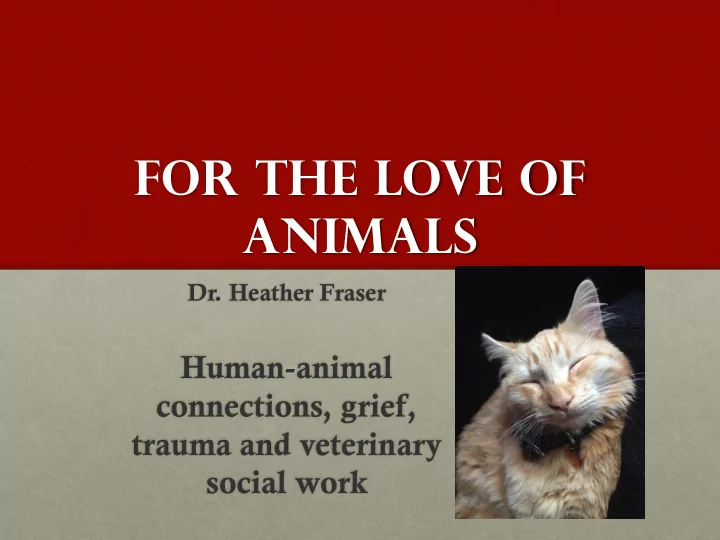

For the love of animals Dr. Heather Fraser Human-animal connections, grief, trauma and veterinary social work
OVERVIEW 1.Connections 2.Grief 3.Trauma 4.Veterinary social work
CONNECTIONS Connections: relationships and associations, something that joins two or more things; energy fields, often pleasurable and productive Animals can help us connect with each other and ourselves. They can allow us to feel loved, understand more about ourselves and connect with the wider, physical, natural environment. They can help us feel alive. Women, men, children. Fat, skinny, straight or queer. Black or white, rich or poor, talented or not. We can feel accepted without judgement (see Faver & Cavazos, 2008; Serpell 1996).
cONNECTIONS From Taylor and Fraser (forthcoming) focus group study and a much wider literature review we know that animals are often our: Family members + loved ones (also see Cohen, 2002) Companions in sickness and in health (also see Siegel, 1990) But that… speciesism often prompts us to apologise or underplay these connections to avoid being mocked, or minimise our ethical obligations (see Ryan, 2011)
GRIEF Grief: mental suffering over loss, especially the death of a loved one. Grief often manifests on and through the body, disturbing daily routines. Humans can mourn the loss of animals as deeply as they can the loss of other humans. Regret and self recrimination may be part of the loss. Needing to make this point seems obvious and sad to me. Yet, some people still need convincing. It is still easy to mock people who deeply mourn the passing of non human animals.
GRIEF “It's arrogant to think we're the only animals who mourn” (Bekoff, 2009). Eg: loss of appetite, playfulness, refusal to believe the dead is actually dead, sunken expressions, appearance of being lost, difficulty sleeping, failing to thrive etc (Wong, 2013). Many animal species have their own ways of honouring the dead. And they are just the ways that humans recognise . And we don’t have a bird’s eye view, even when we think we do!
TRAUMA Trauma: a serious wound or injury, that is deeply distressing and often has lasting effects, some of which can negatively impair our ability to function, trust, love and thrive. It is not surprising that people seek solace from their relationships with companion animals, who help them to heal, soothe, recover from a wide range of traumatic events, from serious illness, rape and battlefield traumas. This help can be at least as important as human based therapy, surgery and medication. PTSD is a well known human condition amenable to the therapeutic interventions of animals, both domesticated and wild.
TRAUMA And humans are not the only ones to feel traumatised. Other animals can feel a range of emotions, including those related to trauma, or deeply distressing experiences that can leave scars (Bekoff, 2009; Wong, 2013). By helping traumatised companion animals we often help soothe our own wounds. Some of the strengths of the human-animal bond include the acceptance, playfulness, touch and security offered. They can help us deal with depression (Souter & Miller 2007). We can experience ourselves in different, non-pathologised and non-stigmatised ways (also see Sable, 2013).
VETERINARY SOCIAL WORK 4 pillars of VSW are: 1. Grief and pet loss 2. Animal assisted interventions (see Fine,2010) 3. The Link between human and animal abuse 4. Compassion fatigue for people working in the area of animal abuse
VETERINARY SOCIAL WORK Took me a really long time to take animal rights seriously. Many reasons why but the ethics finally won the day … “…animals have already made their way into social work modes and fields of practice (Tedeshi et al. 2005) . Ignoring them is no longer legitimate, if it ever was. Accordingly, we cannot ethically promote therapeutic interventions with clients that “use” animals simply as “tools” without regard to their needs or interests… (Taylor, Fraser, Signal & Prentice, BJSW , forthcoming)
References Bekoff, M. (2009) Animal Emotions, http://www.psychologytoday.com/blog/animal- emotions/200910/grief-in-animals-its-arrogant-think-were-the-only-animals-who-mourn Carter, B., & Charles, N. (2011). (Eds.) Human and other animals: Critical perspectives . Basingstoke, UK: Palgrave Macmillan. . (2002). Can pets function as family members? Western Journal of Nursing Research, 24, Cohen, S.P 621 – 638. Evans, N. & Perez-y-Perez, M. (2013). Will Marley come home? An exploration of the impacts of the Canterbury earthquakes on people’s relationships with their companion animals, Aotearoa New Zealand Social Work , 25 (2), 7-17. Faver, C.A. & Cavazos, A.M. (2008). Love, Safety and Companionship: The Human Animal Bond and Latino Families, Journal of Family Social Work , 11(3), 254-271. Fine, A.H. (2010). (Ed). Handbook on Animal-Assisted Therapy, Theoretical Foundations and Guidelines for Practice , 3rd ed, Burlington: Academic Press. Flynn, C. (2000a). Woman's best friend: Pet abuse and the role of companion animals in the lives of battered women. Violence Against Women , 6, 162-177. Fraser, H. & Taylor, N. (forthcoming). In good company, women, companion animals and social work… Society and Animals
References Risley-Curtiss, C., Holley, L.C. & Kodiene , S. (2011). “They’re There for You”: Men’s Relationships with Companion Animals, Families in Society: The Journal of Contemporary Social Services , 92 (4), 412-418. Ryan, T. (2011). Animals and social work: A moral introduction. Basingstoke, UK: Palgrave Macmillan. . (2013). The Pet Connection: An Attachment Perspective. Clinical Social Work Sable, P Journal , 41, 93-99. Serpell, J. (1996). In the company of animals: A study of human animal relationships. Cambridge. Cambridge University Press. Siegel, J. (1990). Companion animals: in sickness and in health. Journal of Social Issues , 49(1), 157-167. Souter M., & Miller M. (2007). Do animal-assisted activities effectively treat depression? A meta-analysis. Anthrozoos, 20, 167-180. Taylor, N., Fraser, H ., Signal, T. and Prentice, K. (2014) ‘ Social work, animals and ethics: a case study of an animal assisted therapy program for child sex abuse victims,’ British Journal of Social Work Wong, K. (2013) How to Identify Grief in Animals, Scientific American, June 18 th http://www.scientificamerican.com/article/grief-creature-compassion-how-to-identify- grief-in-animals/
Recommend
More recommend